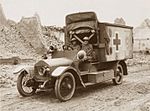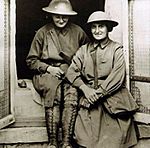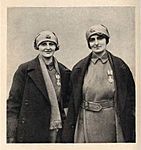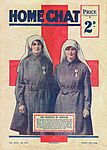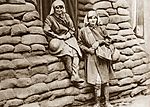Elsie Knocker facts for kids
Quick facts for kids
Elsie Knocker
|
|
|---|---|
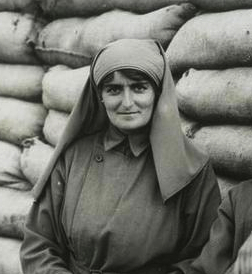
One of "The Madonnas of Pervyse"
|
|
| Born |
Elizabeth Blackall Shapter
29 June 1884 Exeter, Devon, England
|
| Died | 26 April 1978 (aged 93) Ashtead, Surrey, England
|
| Education | St. Nicholas's, Folkestone Château Lutry, Switzerland |
| Years active | September 1914 – March 1918 |
| Medical career | |
| Profession | Nurse |
| Institutions | Children's Hip Hospital, Sevenoaks Queen Charlotte's Hospital Munro Ambulance Corps |
| Awards | Order of Léopold II (1915), Military Medal (1917), Order of St. John of Jerusalem (1918) |
Elsie Knocker, later known as Baroness de T'Serclaes, was a brave British nurse and ambulance driver. She lived from 1884 to 1978. During World War I, she and her friend Mairi Chisholm saved thousands of soldiers' lives. They worked on the Western Front in Belgium. The newspapers called them "The Madonnas of Pervyse". They were some of the most photographed women of the war. Elsie and Mairi earned many medals for their courage.
Contents
Elsie Knocker's Life Story
Growing Up and Early Career
Elsie Knocker was born Elizabeth Blackall Shapter in Exeter, Devon, England, on June 29, 1884. She was the youngest of five children. When she was young, her parents passed away. She was then adopted by Lewis Edward Upcott and his wife Emily. Elsie went to school in Folkestone, England, and later in Switzerland.
After her schooling, Elsie trained at the Children's Hip Hospital in Sevenoaks. In 1906, she married Leslie Duke Knocker. They had a son named Kenneth Duke a year later. Their marriage ended, and Elsie began training as a midwife at Queen Charlotte's Hospital.
Elsie loved motorbikes and riding them. She was a keen amateur motorbike rider. She even earned the nickname "Gypsy" because she loved being on the open road. She owned several motorbikes, including one with a sidecar. This sidecar motorbike would later go with her to the war front.
Helping in World War I
When World War I began in 1914, Elsie wrote to her friend Mairi Chisholm. Mairi was also a motorbike enthusiast. Elsie suggested they go to London to help as dispatch riders. Mairi was chosen to join Hector Munro's Munro Ambulance Corps. Mairi convinced Munro to also accept Elsie. Elsie had some nursing training and was a great mechanic and driver. She also spoke French and German.
First Aid on the Front Lines
On September 25, 1914, Elsie, Mairi, and other volunteers arrived in Ostend, Belgium. They worked hard picking up wounded soldiers. They brought them back to a hospital away from the fighting. Elsie and Mairi soon realized they could save more lives. They decided to treat the wounded soldiers directly on the front lines.
In November, they left the ambulance corps. They set up their own first-aid station in Pervyse. This town was only about 100 yards from the trenches. They used a vacant cellar and called it the "British First Aid Post." For the next three and a half years, they helped wounded soldiers in the Belgian area. Elsie gave most of the medical care. Mairi transported the injured, often under fire, to a main hospital.
They had to raise their own money for their station. They used donations to make the cellar stronger with concrete. They also added a steel door. Elsie managed to get them officially working with the Belgian army there. Both women took many photos of each other and the suffering around them.
In January 1915, King Albert I of Belgium honored them. He gave them both the Order of Léopold II medal for their brave work.
Marriage and Continued Service
In January 1916, Elsie married Baron Harold de T'Serclaes. He was a pilot in the Belgian Flying Corps. Elsie wrote that she was swept up in the excitement of marriage. She felt it was a small risk compared to risking her life at the front. She also hoped her son Kenneth would have a father. After a quick honeymoon, they rarely saw each other. Elsie was busy at Pervyse, and her husband returned to his squadron.
Elsie and Mairi continued to rescue soldiers on the battlefield. They even carried wounded men on their backs to their first-aid station. They rescued a wounded German pilot in No Man's Land. For this, both women received the British Military Medal. They were also made Officers of the Most Venerable Order of St. John of Jerusalem.
Another volunteer, May Sinclair, said Elsie "had an irresistible inclination towards the greatest possible danger." As news of their bravery spread, journalists and important people visited them. They became some of the most photographed women of the war.
In March 1918, both women were gassed during a German attack. They had to return home to Britain. They spent the rest of the war in Britain. They joined the newly formed Women's Royal Air Force.
After the Wars
After World War I, Elsie's marriage to the Baron ended. She was allowed to keep the title of Baroness. Her friendship with Mairi Chisholm also ended.
In 1939, when World War II started, the Baroness joined the Women's Auxiliary Air Force (WAAF). She became an officer in February 1940. She worked with RAF Fighter Command and rose to the rank of Squadron Officer. She was honored twice for her service.
A sad event happened on July 3, 1942. Her son, Kenneth Duke Knocker, was killed. His plane was shot down over Groningen. Elsie left the RAF in October 1942 after her son's death. She also needed to care for her elderly foster-father.
After World War II, the Baroness helped raise money for the RAF Association. She lived in Ashtead, Surrey, in a house she called 'Pervyse'. Later in life, she started breeding Chihuahuas. She was often seen walking her pets on Ashtead Common. She was known for her colorful clothes and large earrings. On April 26, 1978, the Baroness passed away at age 93.
Awards and Decorations
Diaries and Memories
The Imperial War Museum keeps Elsie Knocker's diaries. They also have recordings and written copies of her interviews.
Memorials
In November 2014, a statue of Elsie Knocker and Mairi Chisholm was revealed. It is in the garden of the Hotel Ariane in Ypres, Belgium. In November 2017, Elsie Knocker was honored with a blue plaque. This plaque is on the house where she was born in Exeter.
Gallery
-
Elsie Knocker and Mairi Chisholm in their converted Wolseley Ambulance, Pervyse, Belgium, around 1916.
-
Elsie Knocker and Mairi Chisholm outside their advanced first-aid station in Pervyse, Belgium, around 1918.
See also


